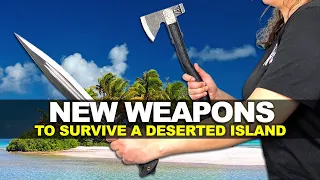Bushcraft vs Survival Knives: Which Blade Would You Trust in the Wild?
November 3rd, 2025
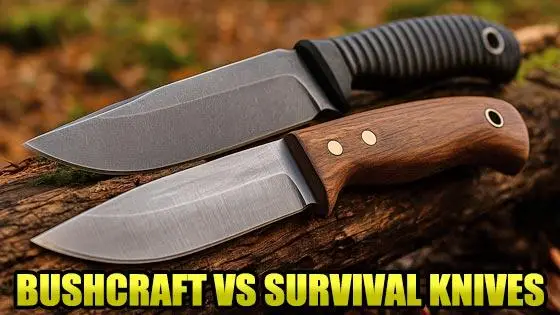
Picture this: you're deep in the woods with the sun fading fast, rain starting to fall, and the temperature dropping by the minute. Your pack is soaked, the matches are useless, and the only thing you can count on is the knife at your side. In that moment, whether you're holding a bushcraft knife or a survival knife could make a serious difference. Both blades are built for life outdoors, but they serve slightly different masters. One is a precision tool for carving, crafting, and controlled work. The other is a no-nonsense powerhouse built to chop, split, and cut its way through just about anything. Understanding the difference between these two can mean the difference between a comfortable night by the fire and a cold, frustrating one in the dark.
What Exactly Is a Bushcraft Knife?
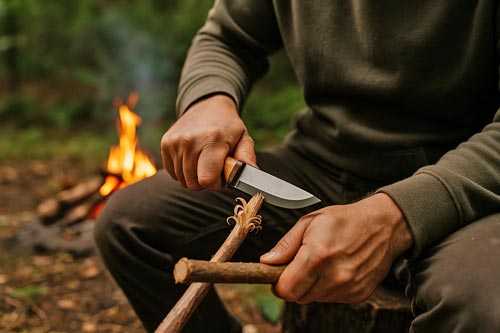
A bushcraft knife is the tool of choice for people who love the art of living outdoors. Bushcraft itself is about thriving in nature through skill, carving, fire-making, shelter-building, and working with wood and natural materials. A good bushcraft knife reflects that mindset. It usually has a shorter, sturdier blade with a Scandi grind, allowing for controlled carving and clean cuts without digging too deep into the material. This makes it perfect for crafting tent stakes, feather sticks, traps, and tools out of wood.
Bushcraft knives often feature high-carbon steel blades for easy sharpening in the field, along with simple, comfortable handles that reduce fatigue during repetitive work. They are not flashy, and they are not designed to chop through car doors or split large logs. Instead, they excel in fine-tuned precision, helping you work smarter and more efficiently when you are relying on skill and patience rather than brute strength.
What Makes a Survival Knife Different?

A survival knife is built for versatility and raw strength. It is the kind of blade you can rely on when things go wrong, whether that means cutting rope, building shelter, or preparing food in tough conditions. Unlike a bushcraft knife, which focuses on precision and control, a survival knife is designed to handle a wider range of demanding tasks. It can chop, pry, carve, or even serve as a last-resort weapon if necessary.
Most survival knives feature thicker blades and stronger spines for heavy-duty work. They are often made with full tang construction, giving them the strength to withstand batoning, hammering, or other high-stress activities. The blade shape can vary, but drop point and clip point designs are the most common because they offer a good balance of cutting power and control. Many also include serrations, sawbacks, or multi-functional sheaths with built-in sharpeners or fire starters. A true survival knife is a dependable tool for unpredictable situations where reliability matters more than refinement.
When to Choose a Bushcraft Knife Over a Survival Knife
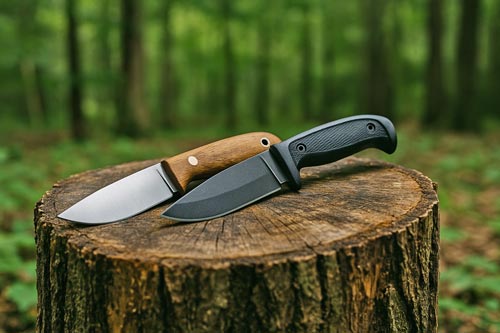
Deciding between a bushcraft knife and a survival knife comes down to how you spend your time outdoors. If your focus is learning and practicing wilderness skills, such as carving tools, making feather sticks, or crafting traps, a bushcraft knife is the better fit. It gives you control and precision, letting you work efficiently with wood and natural materials. Bushcraft is about skill and technique, not brute force, so a smaller, finely ground blade performs best.
If your adventures lean more toward unpredictable conditions or emergency preparedness, a survival knife will serve you better. It is built for versatility and toughness, capable of handling heavy cutting, prying, and splitting tasks that a bushcraft knife is not designed for. Many people who spend a lot of time outdoors carry both, using a bushcraft knife for detail work and a survival knife for situations where strength and durability matter most.
When it comes to choosing gear you can trust, quality makes all the difference. For blades built to handle real outdoor challenges, check out our full selection of survival knives and find the one that fits your adventure style.
Blade Design and Materials: Why the Details Matter

The blade design of a knife has a huge impact on how it performs in the field. A bushcraft knife usually has a Scandinavian, or Scandi, grind that provides excellent control for carving and shaping wood. The single bevel makes it easier to maintain a consistent angle when sharpening and helps prevent the blade from biting too deep into the material. A survival knife, by contrast, often uses a flat or convex grind for added strength, allowing it to handle rougher jobs like chopping and batoning without chipping the edge.
Steel type is another critical factor. High carbon steel is favored by many outdoorsmen for its ability to take a razor-sharp edge and sharpen easily, even with basic tools. However, it requires more maintenance to prevent rust. Stainless steel offers better corrosion resistance and can withstand damp or coastal conditions, though it may be harder to sharpen in the field. Modern manufacturers sometimes use hybrid alloys that combine the best of both worlds, giving you durability, edge retention, and rust resistance in one blade.
Handle design and material also matter more than most people realize. A knife should feel secure and balanced in your hand, especially when working for long periods. Rubberized, micarta, or G10 handles provide grip even when wet, while wood or leather handles offer classic appeal and comfort. Choosing the right combination of blade geometry and handle style is what turns an ordinary knife into a dependable piece of gear you can trust in any situation.
Which Knife Is Better for Beginners?
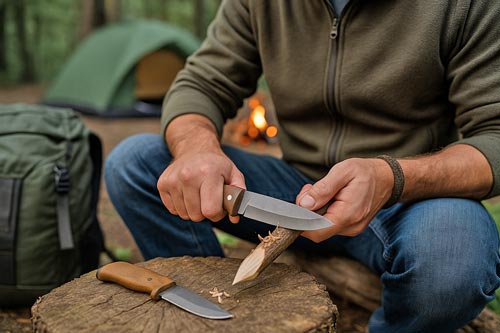
For beginners who are just getting into outdoor adventures, a bushcraft knife is often the best place to start. Its smaller blade and simpler grind make it easier to control, and it teaches proper knife technique through practice rather than force. A good bushcraft knife encourages precision and safety, which helps new users build confidence as they learn carving, fire-making, and general campcraft skills.
A survival knife is better suited once you have more experience or plan to take on demanding trips. It requires a bit more strength and understanding of how to use the blade efficiently without overworking it. Many experienced outdoorsmen own both, starting with a bushcraft knife to develop skill and adding a survival knife later for tougher, all-purpose use. Whichever you choose first, the most important thing is to invest in quality and keep your knife sharp, clean, and well cared for.
Choosing the Right Knife for the Journey Ahead

At the end of the day, both bushcraft and survival knives have earned their place in the packs of outdoorsmen around the world. A bushcraft knife shines when precision and technique matter most, letting you carve, craft, and create with control. A survival knife steps in when conditions get tougher, offering the strength and versatility to power through the unknown. Together, they represent two sides of the same coin, one built on skill and the other on strength.
If you spend time outdoors, learning how to use each type of blade will make you more capable, confident, and prepared for whatever the wilderness throws your way. Whether you are planning a weekend camping trip or building your emergency go-bag, the right knife can make all the difference. To compare rugged outdoor blades designed for real-world use, take a look at our current lineup of outdoor survival knives and find the one that fits your style.
You May Also Be Interested In:
- Survival Walking Stick and Other Gear to Survive in the Wild!
- EDC Knives for Beginners: How to Choose Your First Everyday Carry Blade
- Military Survival Knives: Features That Could Save Your Life
- Best Non-Lethal Self Defense Weapons You Can Trust
- Everyday Carry for Self Defense: Practical Tools You Can Trust
- New Weapons to Survive in the Wild!
- Steampunk Gun Blade and Other Unusual Weapons
- Which Knife Would You Choose To Survive In The Wild?
- Hidden Blade Knuckles and Other Dangerous Weapons!
- Hidden Blade Walking Stick and Other Dangerous Weapons
Leave a Reply





